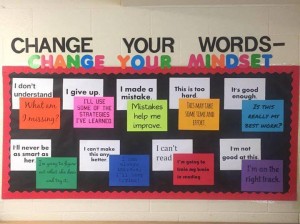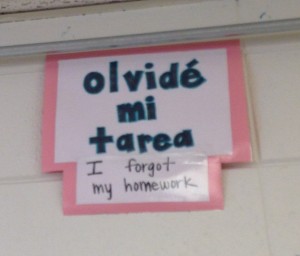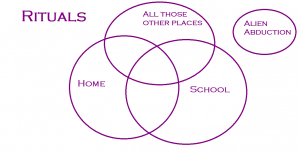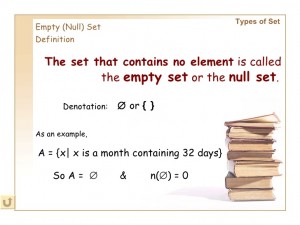
Han: Lando.
Leia: Lando system?
Han: Lando’s not a system. He’s a man. Lando Calrissian. He’s a card player, gambler, scoundrel. You’d like him.
Leia: Thanks.
Time for another short play to break up all this expository writing.
The Search for Blando Blarney
It’s a windy, cold February day, expected to hit zero degrees by morning. Shasta and Mommy are staying at the Westin in Wheeling for another Capricon, a favorite science fiction convention that mommy attends each year. Mommy has put on her soft, gray owl shirt. The owl looks fried, more stoned than any pet rock. Mommy looks tired and fried, too. She is getting jobs. She added Dagobah #203 after trying to get a long-term sub job. She expects to add Hoth #456 next week. Endor #Whatever may have gotten away, though. Mommy hit send on the app and then failed to pick up a call from Principal Blando Blarney of Pooperscooper Middle School, not finding its traces on the landline for a couple of days. Blarney has not returned two calls. Endor may have slipped through mommy’s clutching fingers.
Shasta is wearing a shiny red spandex outfit, skin tight around her slug’s body. Shasta is an invisible slug, about as large as a medium-sized dog. She has abandoned the usual top hat in favor of a long-haired, purple wig, held on by a copper-colored pair of steampunk goggles covered with wheels and gears. She is resting on a simple, black velvet flying carpet, about five feet off the floor, in the space between the two double bed in the Westin Hotel room. Shasta wonders what mommy is doing.
Shasta: Why do we want Blando Blarney to talk to us mommy?
Mommy: The suburb is right next door. I hear it pays well, too.
Shasta: Do you even like subbing?
Mommy: I don’t know. Maybe I will when I actually get around to it. As far as I can tell, I mostly hunt for jobs for no pay yet. My job is to do job interviews. Just like I write a top-secret blog with 13,703 users that makes no money whatsoever. I seem to have a real knack for not making money.
Shasta: Well, who needs money?
Mommy: It’s good to be a giant, invisible, young slug. I’d like that uncomplicated life. I don’t want to interfere with the purity of your vision, but money is kind of useful. You want a great mystery? I have a graduate degree in marketing from a school that is rated among the best in the country. I know I could market. Hell, I once wrote an article for Home Office Computing Magazine that made a small, software company’s year. I could market. But I don’t.
Chekhov is about to be captured. Oops. Now he is about to have a seemingly catastrophic fall.
Shasta: It’s that “kind of useful” mommy. If you went for money, you would get money, whether you or the owl are fried or not. But I am worried about this subbing thing.
Mommy: It seems like a natural move. I qualify. I like the idea of working a few days a week, days of my choice. It doesn’t pay well but it’s a few bucks more than double the minimum wage and that idea of being able to work or not work whenever I want does appear to be a real perk. Once I find the right classrooms, the job might even be fun.
Shasta: Don’t think too hard. That’s what I always say. But this may be one of those pigs have wings things. We have to do some thinking on this one, mommy, we do. This might be a thinking type thing. This might even be a hell no I won’t go. Just because the path goes ever onward, doesn’t mean we have to stay on the path. In fact, that “ever onward” might be a great reason to get off the path. Now.
How about that Starbucks? You could get a green apron! I’d rather have a green apron than a badge that opens school security doors. I’d like to hit those security doors with a blaster. And I’d rather have a free pound of coffee every week than an extra couple hundred of dollars after four weeks of hell.
Mommy: You need to have a more positive attitude!
Shasta: No, I don’t. Everybody talks about that dumb positive attitude. Everybody talks about gratitude. And gratitude journals. And how great Mr. Spock is. But that doesn’t mean they are right.
Mommy: They are about Mr. Spock, although I am not sure everyone is talking about him. Not even here, and we may have a biased sample. This is a science fiction convention. They are probably right about gratitude, too.
Shasta: (Looking at Captain Kirk and Mr. Spock on the TV.) I sure hope they save those humpback whales. But you get what I mean. Yes, be positive. Be grateful. But don’t let that control your life. Too much positive and you keep on that forever path. You stay when you ought to go.
Mommy: Too true.
Shasta: That Blarney guy should be an object lesson. Did he make you feel good? No, he did not. I say, make lattes, not war. Or maybe even try to do something practical with the blog. Or another blog. Or etched glass. Or, I don’t know, anything. But something different. Not classroom management. It doesn’t matter how good you are. It’s still tweezing slivers out of festering skin.Classroom management is never as much fun as etching glass or writing blog posts. Especially nowadays.
Mommy: (Smiling, intrigued.) Why especially nowadays?
Shasta: Because we are saving everyone and anyone. Even when you send them out of class, they send them right back unless they smacked someone or lit a blunt in the middle of class. If a kid sliced his teacher’s desk down the middle with a light saber, he would be back within the hour.
Mommy: They never pull out their blunt in the middle of class. Sometimes it might fall out of their backpack while they are trying to find their homework, but that’s different. There’s a real correlation between red eyes and blunt mismanagement, by the way. You don’t see that problem much in middle school, though, and hardly ever in elementary grades. And I’ve never seen a light saber attack yet.
Shasta: But if you send them out, nothing happens.
Mommy: People call their mommies or daddies when they misbehave. I do, anyway, when I can’t help but see the blunt. Or when I know a kid needs help. We try.
Shasta: You all try too hard. The ones who don’t want to learn? The ones who want to disrupt the class, like the big boy in the last class last week? We should not keep inviting them back into class. It’s like leaving the door open to any Imperial Storm Trooper who promises he gave up violence last week. Right. Like that’s going to happen. Blasters are going off all over America’s schools, and no one even puts up a blast shield. And they keep sending them back to class. Why?
Mommy: Public schools are expected to educate everyone. That’s one reason why so many urban parents opt for charter schools. That’s why public school teachers cannot stem that charter school incursion. What’s curious to me is that you see complaints in the media all the time about how charter schools get their higher performance numbers by throwing out kids who are not succeeding. Yeah. But nobody wants to travel the distance from Point A to Point B in those articles. Yes, charter numbers go up because those schools chucked their miscreants out. The numbers for any school would go up if the school did that.
But the assumption seems to be that these schools are throwing out innocent, slow learners. I’d guess that’s almost entirely crap. I’d put my money on the fact that a hard-working slow learner who listened in class and kept trying to master new material would be welcome to stay in those charter schools. Teachers would advocate for the kid, for one thing. Educators and administrators don’t give up on kids who are genuinely trying. Also, those kids tend to get improving test scores. They may not do great on the state test, but administrators can show progress in benchmark testing. Kids who try to learn almost always succeed in learning, even if they may not move as fast as most of their classmates.
Some kids are not trying, though. And I admit you have a point, Shasta. By middle school, a few kids always walk into class with red eyes. Or they raise a ruckus almost every day somewhere, in some part of the school. Like Freddie[1]. One of the special education teachers asked about Freddie yesterday. She wanted to help him last year. So I texted my favorite colleague, Vasco de Gama[2] for a report. Here’s the exact text: “(Unrelated science stuff) But Freddie has been awful. He would have been sent to another school long ago but ROE[3] won’t take him. He had a very good Thursday and Friday, for what it’s worth. Best in a very long time.”
Apparently, Freddie did pass seventh grade despite the fact that he knew virtually none of last year’s material and did not try to learn it. Everyone passed no matter what they knew. I talked to his mom last year about possible special education placement. I’d say he is oppositionally defiant, among other considerations. His behavior has been making learning impossible for him and everyone near him. But he does not want to be in special education and he seems to run his mom, not the other way around.
It’s a mess, Shasta. We have no clue what to do with our Freddies. And idealists want to make sure the Freddies don’t miss the chance to get an education. We have to keep them in school. In the meantime, they harass other kids and their teachers, then take up days of Dean time – and I mean full days in some cases – while regularly disrupting classes. That’s another thing that doesn’t hit the media radar. Sometimes most of a school’s referrals are coming from only a small group of kids. But if the alternative school won’t take the Freddies, who will? They are guaranteed the right to go to school.
Shasta: Mommy, Big Boy in that social studies class last week was a Freddie. You know it. If you sub for that lady again, you will have him again.
Mommy: For one period and I am good with my Freddies. I know them well enough by now. That’s one reason why I can be a good sub.
Shasta: Yes, but it’s also a good reason to go get your green apron. You don’t need that level of crazy. You just want to get out of house a bit, but mostly you like to blog and write. Why set yourself up?
Mommy: I love kids, Shasta. I miss kids. I loved the little drawing that girl did for me on my kindergarten day. And I loved it when that middle-school girl said I was her new, favorite substitute teacher. I enjoyed teaching Spanish. The kids and I mostly had fun while I taught useful stuff. Well, mostly useful stuff. I am not too sure about the capitols of Bolivia and Ecuatorial Guinea. I mean, yes, great stuff capitols and all, but maybe we should work on being able to find the states in the United States. Or the continents. We have fallen a bit behind on the basics. But I guess we have to start somewhere and who knows when someone will suddenly be transported to Montevideo. How embarrassing if that person did not realize that he or she had materialized in the capitol of Uruguay.
Shasta: Mommy, you are trying to distract me, trying to distract us. Although maybe it would be good if Scotty beamed you to Montevideo. You could use some time to consider your options before you just leap into a classroom. Those two subbing days were kind of stressful.
Mommy: The days will be easier when I get the rhythm of this subbing thing and figure out where to work and where not to work.
Shasta: (Sighs.) Oh, mommy, don’t be so silly. Go get your apron! They are letting the Freddies run loose. You don’t have to work that hard. You just don’t, never again. Especially since nobody even seems grateful anymore. They stick people with Freddies then criticize them for the lack of learning taking place in classrooms with high numbers of Freddies. They are mean to teachers now, meaner and meaner.
Mommy: Yes, I am afraid that’s true, and poor and urban classrooms will always have more Freddies. I’m not sure why some kids become Freddies while most don’t, but I know that missing daddies, mommies in jail, evictions and no food sure can make some Freddies. Too much gunfire outside the window at night creates a Freddie day even in a room that’s normally quiet and attentive.
Shasta: What are we doing today anyway?
Mommy (laughs): Yeah, enough deep thought. At 11:30, I want to go to the panel on antibiotics. I need a shower, first. Then the usual: art show, panels, dealers room, con suite. There’s a Star Wars panel. And that Klingon girl is giving a concert. We are going to have linner at a place with the good pretzels, crab cakes and brussels sprouts.
Shasta: (Doubtfully.) Brussel sprouts?
Mommy: Yumm.
Shasta: Are we really going to pursue that Blando guy?
Mommy: Nope. He ducked two calls. That’s enough I guess. Waste of an application. But we have all of cyberspace. We can apply anywhere! I’d say it’s Endor’s loss, some other district’s gain.
Shasta: If you are smart, it will be Starbuck’s gain.
Mommy just smiles gently at Shasta, who does not get it. Mommy does not mind the miscreants. She likes all kinds of kids. It really is a pity that the nutcase who apparently quit her old district in the middle of this school year drove mommy into retirement. But she did not have another year of incomprehensible tests in her. Mommy spent about 20% of her last year giving obligatory tests and quizzes written by other people, some of them members of an East Coast consulting firm that has since gone bankrupt. Her bilingual students often could not even read those tests. Nutcase kept telling her that it was her fault that students were not prepared for the tests, even though benchmark tests showed the average academic level of her classes was somewhere in the third grade, while the tests were written to match seventh grade common core standards. You need to have faith in your students, Nutcase would say, when mommy pointed out the kids could not read the tests, much less do the math. The schools own benchmark testing completely supported mommy’s contention. No excuses, Nutcase would say.
Oh, Mommy is glad not to have to get up in the morning to go try to do six impossible things before breakfast. Mommy reaches for her shoes, preparing to go out for a fun day.
All’s well that ends well, she thinks.
Eduhonesty:
Han: “I could arrange for you to receive orders to conquer Coruscant, but your only resources would be twelve drunken Ewoks, four malfunctioning speeders, and forty kilos of beach sand.”
Ms. Q: “That’ll take at least two weeks, sir.“―Han Solo and Ms. Q
(The story of education today.)
[1] An alias, probably the first of many
[2] Not his real name. Not in this time on this planet anyway.
[3] ROE is the Regional Office of Education. They run the “safe schools” for a county. In theory, if a child cannot manage public school, that child can be sent to a safe school. Common reasons for placement include drugs, violence, and zero tolerance violations such as a knife in a car or liquor in a locker. But ROE refuses kids regularly. For that matter, I vividly remember one incident in which a student struck a teacher and was sent away to the safe school. The safe school sent her back less than a month later because she was behaving so badly there that they threw her out. But this was a middle school student. The public schools could not expel the girl due to her age. The teacher who had been hit found the girl back in school only a few weeks after she had been sent away. That naturally made the teacher extremely nervous. She vented often during lunch in the teacher’s lounge. I felt profoundly sorry for that teacher, and for the students in that girl’s classes. Off-the-chain students steal learning time from everyone, sometimes huge, jagged chunks of learning time. At least, the girl was not returned to the nervous teacher’s classroom. Despite the shortage of special education teachers, the administration managed to do that much right, at least.


 (For
(For





 Please
Please


